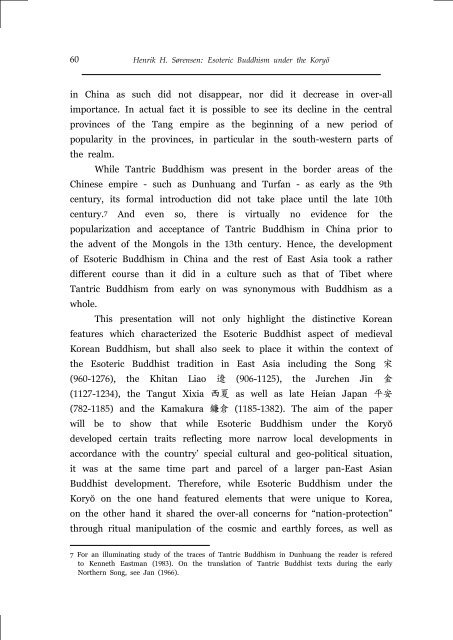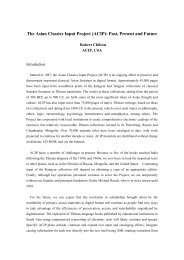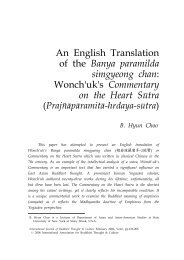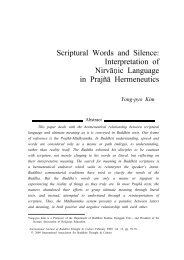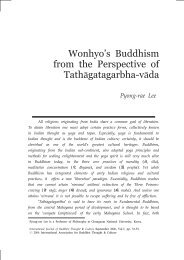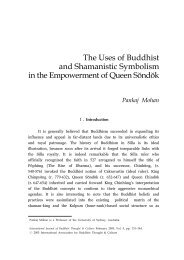Esoteric Buddhism under the KoryÅ in the Light of ... - Buddhism.org
Esoteric Buddhism under the KoryÅ in the Light of ... - Buddhism.org
Esoteric Buddhism under the KoryÅ in the Light of ... - Buddhism.org
You also want an ePaper? Increase the reach of your titles
YUMPU automatically turns print PDFs into web optimized ePapers that Google loves.
60<br />
Henrik H. Sørensen: <strong>Esoteric</strong> <strong>Buddhism</strong> <strong>under</strong> <strong>the</strong> Koryŏ<br />
<strong>in</strong> Ch<strong>in</strong>a as such did not disappear, nor did it decrease <strong>in</strong> over-all<br />
importance. In actual fact it is possible to see its decl<strong>in</strong>e <strong>in</strong> <strong>the</strong> central<br />
prov<strong>in</strong>ces <strong>of</strong> <strong>the</strong> Tang empire as <strong>the</strong> beg<strong>in</strong>n<strong>in</strong>g <strong>of</strong> a new period <strong>of</strong><br />
popularity <strong>in</strong> <strong>the</strong> prov<strong>in</strong>ces, <strong>in</strong> particular <strong>in</strong> <strong>the</strong> south-western parts <strong>of</strong><br />
<strong>the</strong> realm.<br />
While Tantric <strong>Buddhism</strong> was present <strong>in</strong> <strong>the</strong> border areas <strong>of</strong> <strong>the</strong><br />
Ch<strong>in</strong>ese empire - such as Dunhuang and Turfan - as early as <strong>the</strong> 9th<br />
century, its formal <strong>in</strong>troduction did not take place until <strong>the</strong> late 10th<br />
century. 7 And even so, <strong>the</strong>re is virtually no evidence for <strong>the</strong><br />
popularization and acceptance <strong>of</strong> Tantric <strong>Buddhism</strong> <strong>in</strong> Ch<strong>in</strong>a prior to<br />
<strong>the</strong> advent <strong>of</strong> <strong>the</strong> Mongols <strong>in</strong> <strong>the</strong> 13th century. Hence, <strong>the</strong> development<br />
<strong>of</strong> <strong>Esoteric</strong> <strong>Buddhism</strong> <strong>in</strong> Ch<strong>in</strong>a and <strong>the</strong> rest <strong>of</strong> East Asia took a ra<strong>the</strong>r<br />
different course than it did <strong>in</strong> a culture such as that <strong>of</strong> Tibet where<br />
Tantric <strong>Buddhism</strong> from early on was synonymous with <strong>Buddhism</strong> as a<br />
whole.<br />
This presentation will not only highlight <strong>the</strong> dist<strong>in</strong>ctive Korean<br />
features which characterized <strong>the</strong> <strong>Esoteric</strong> Buddhist aspect <strong>of</strong> medieval<br />
Korean <strong>Buddhism</strong>, but shall also seek to place it with<strong>in</strong> <strong>the</strong> context <strong>of</strong><br />
<strong>the</strong> <strong>Esoteric</strong> Buddhist tradition <strong>in</strong> East Asia <strong>in</strong>clud<strong>in</strong>g <strong>the</strong> Song 宋<br />
(960-1276), <strong>the</strong> Khitan Liao 遼 (906-1125), <strong>the</strong> Jurchen J<strong>in</strong> 金<br />
(1127-1234), <strong>the</strong> Tangut Xixia 西 夏 as well as late Heian Japan 平 安<br />
(782-1185) and <strong>the</strong> Kamakura 鐮 倉 (1185-1382). The aim <strong>of</strong> <strong>the</strong> paper<br />
will be to show that while <strong>Esoteric</strong> <strong>Buddhism</strong> <strong>under</strong> <strong>the</strong> Koryŏ<br />
developed certa<strong>in</strong> traits reflect<strong>in</strong>g more narrow local developments <strong>in</strong><br />
accordance with <strong>the</strong> country’ special cultural and geo-political situation,<br />
it was at <strong>the</strong> same time part and parcel <strong>of</strong> a larger pan-East Asian<br />
Buddhist development. Therefore, while <strong>Esoteric</strong> <strong>Buddhism</strong> <strong>under</strong> <strong>the</strong><br />
Koryŏ on <strong>the</strong> one hand featured elements that were unique to Korea,<br />
on <strong>the</strong> o<strong>the</strong>r hand it shared <strong>the</strong> over-all concerns for “nation-protection”<br />
through ritual manipulation <strong>of</strong> <strong>the</strong> cosmic and earthly forces, as well as<br />
7 For an illum<strong>in</strong>at<strong>in</strong>g study <strong>of</strong> <strong>the</strong> traces <strong>of</strong> Tantric <strong>Buddhism</strong> <strong>in</strong> Dunhuang <strong>the</strong> reader is refered<br />
to Kenneth Eastman (1983). On <strong>the</strong> translation <strong>of</strong> Tantric Buddhist texts dur<strong>in</strong>g <strong>the</strong> early<br />
Nor<strong>the</strong>rn Song, see Jan (1966).


